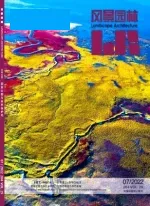基于自然的解决方案

世界银行在2008年发布的报告《生物多样性、气候变化和适应性:世界银行投资中基于自然的解决方案》中,首次提出了基于自然的解决方案(NbS),阐述为“更系统地理解人与自然的关系”,并在10余年间将此概念整合到斯里兰卡科伦坡湿地支持城市防洪、越南红树林恢复等约100个投资项目中。NbS日益成为自然资源管理和生态保护等领域关注的热点,其理念与技术方法被越来越多地用于讨论和实践。世界自然保护联盟(IUCN)后又作出如下定义:通过保护、可持续管理和修复自然或人工生态系统,有效地和适应性地应对社会挑战,并为人类福祉和生物多样性带来益处的行动;同时,建议用NbS应对气候变化。
只有更好地认识自然,才能找到基于自然的最佳解决方案。人们一直都在探索和学习与自然相处之道。亚马孙流域的原住民针对森林的烟火建立了“森林岛”管理策略,“以火攻火”——定期点燃部落周围的小块森林,清除容易引发火灾的灌木和杂草,这样可以释放植物养分,提升农田的生产能力,提高森林应对气候变化的抵御能力。这一系列发源于农业原型的解决方案,以系统观的生态手段应对自然灾害、提升生产力,构建了更加稳定和具有生命力的人居社会-生态系统。
中国亘古以来都在对自然进行认知和解释。端午节将至,这是一个总会和纪念屈原联系起来的节日。屈原写过一篇很有意思的长诗《天问》,通篇对天地、自然和人世等现象发问,尤其提到上古洪水以及对治水方式的疑问:洪水如渊深不见底,怎样才能将它填平(洪泉极深,何以窴之?),九州大地如何安置?河流山谷怎样疏浚(九州安错?川谷何洿?),大禹从鲧腹中生出,治水方法怎样变化(伯禹愎鲧,夫何以变化?),为何继承前任遗绪,所用谋略却不相同(何续初继业,而厥谋不同?),表现了作者对自然现象和治理方式的大胆怀疑,以及追求真理的探索精神。这也说明了对自然现象的不同认知带来不同的解决方案和效果。而后来的人们在不断探索人与自然关系的过程中,更是凝练出了“师法自然,因地制宜”的创造性解决方案准则。
伊恩·麦克哈格在《设计结合自然》中多次论述人和自然的关系,“自然不是为人类表演舞台提供装饰性的背景……而是需要把自然作为生命的源泉、生存的环境、诲人的老师、神圣的殿堂和挑战的场所来维护,尤其是需要不断地再发现自然界本身还未被我们掌握的规律,寻根求源”。我们需要了解自然的规律、尊重它的忠告,并把自然当作盟友来看待,通过认知自然来揭示和创造出解决方案。
NbS的准则强调采用生物多样性和生态系统方法,提出解决特定社会问题和挑战的方案,在以土地为对象的空间规划设计中,设计师首要的任务是“阅读”自然,每一片土地都是独特的,这种独特性源自其地貌、水文、土壤、气候、植被等自然条件,也源于其上持久人工干预形成的场所与文化。既要持续加深对本地自然知识和传统生态智慧的了解,同时将国土景观以及生态系统进行解译,进而合理选择NbS路径,呈现出土地的独特性并使其永续发展。
当然,从古至今,我们对自然的认知与提出的解决方案是在不断演进的,融合了长期存在于历史发展中的生态智慧和最新的科学知识与实践经验,这是响应多重可持续发展挑战的必由之路。当今的世界是一个高度整合的、人类主导的生态系统,如何以系统性的视角审视自然,促成全新全方位的认知与发现?我们或许也需要如同屈原的《天问》一般,不断发问,不断探索,保持知识的更新和储备,以更独特、精妙和专业的视角认知自然,在自然认知系统之上创造性地提出最佳解决方案,真正做到“师法自然、因地制宜”。

Nature-based Solutions
The World Bank first presented Nature-Based Solutions(NbS) in its 2008 report namedBiodiversity,Climate Change and Adaptation:Nature-Based Solutions in World Bank Investments, and described it as “a more systematic understanding of the relationship between people and nature”. Over the past decade, it has blended this concept into about 100 investment projects, such as the support of Colombo wetland in Sri Lanka for urban flood control, and mangrove restoration in Vietnam. As NbS is increasingly proving to be a hot topic in the field of natural resource management and ecological conservation, its concepts and technical approaches are increasingly being discussed and practiced. The International Union for Conservation of Nature (IUCN) has defined NbS as: actions that effectively and adaptively address social challenges and provide benefits to human well-being and biodiversity through the conservation, sustainable management and restoration of natural or man-made ecosystems. It also suggested tackling climate change by Nature-based Solutions.
It is conditioned only by a better understanding of nature to acquire the best nature-based solutions. People are all the time exploring and learning ways to get along with nature. The aborigines in the Amazon Basin developed a“forest island” management strategy for forest fires, namely“fighting fire with fire”. This aimed to ignite periodically the small patches of forest around the tribe and remove brush and weeds that could easily cause fires. In this way, both the productivity of farmland and the resistance of forests to climate change can be improved through the release of plant nutrients. These serial solutions originating from the agricultural prototype deal with natural disasters and enhance productivity with a systemic ecological approach. It has built a more stable and viable ecosystem for human settlements.
China has been cognizing and interpreting nature from time immemorial. The Dragon Boat Festival is just round the corner, a festival that is always associated with commemorating Qu Yuan. Qu Yuan wrote a long and interesting poem namedTian Wen(Inquiries of Heaven). This poem asks questions about heaven and earth, nature and the human world,especially about the ancient floods and the way they were managed. How can we fill the floods which are as deep as an abyss? How can the land be emplaced? How can the rivers and valleys be dredged? Why is the strategy used different when inheriting the predecessor’s legacy? These questions manifest the author’s bold doubt as to natural phenomena and management methods, as well as his quest for truth. This also illustrates different solutions and effects arising out of different perceptions of natural phenomena. In the process of exploring the relationship between man and nature, people later developed the creative solution guideline on “learning from nature and acting according to circumstances”.
Ian Lennox McHarg expounds the relationship between man and nature several times inDesign with Nature.“Nature is not a decorative backdrop for the stage of human performance ... but it needs us to treat nature as a source of life, an environment for survival, a teacher for instruction, a sacred palace and a place of challenge to maintain, especially needs us to constantly rediscover the laws of nature itself that we have not yet grasped, to search for its root.” We need to know nature’s laws, respect its advice, and treat nature as an ally to reveal and create solutions through the knowledge of nature.
The NbS guidelines accentuate the application of biodiversity and ecosystem approaches and present solutions to specific social problems and challenges. In the spatial planning and design with land as the object, the designer’s first task is to “read” nature. Each piece of land is characterized by uniqueness. This characteristic is derived from its topography,hydrology, soil, climate, vegetation, and other natural conditions, as well as from the places and cultures formed by lasting human intervention. We need to grasp the local natural knowledge and traditional ecological wisdom, while interpreting the national landscape and ecosystems. This aims to choose a reasonable path for Nature-based Solutions so as to present the uniqueness of the land and make it sustainable.
Undoubtedly, our knowledge of nature and proposed solutions has gradually evolved over time. It incorporates long-term ecological knowledge from historical development and the latest scientific knowledge and practical experience.In this way, it is possible to respond to the diverse challenges to sustainable development. In today’s world, a highly integrated, human-dominated ecosystem, how can we look at nature from a systemic perspective and contribute to new and holistic perceptions and discoveries? Perhaps we need to continue questioning, exploring, renewing and stocking knowledge as Qu Yuan, perceiving nature from a more unique, subtle and professional perspective. We also need to put forward creatively the best solutions on top of the natural system, truly “learning from nature and acting according to circumstances”.
Editor-in-Chief: Professor ZHENG Xi
May 28, 2022

